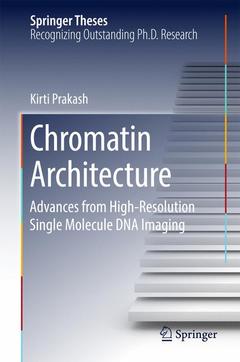Description
Chromatin Architecture, 1st ed. 2017
Advances From High-resolution Single Molecule DNA Imaging
Springer Theses Series
Author: Prakash Kirti
Language: English
Subject for Chromatin Architecture:
Keywords
Superresolution Microscopy; Single Molecule Localisation Microscopy; Genome Architecture; Chromatin Domains; Epigenetics of Meiosis; History of DNA; Interphase Chromosomes; Structure of Chromosomes; Pachytene Chromosomes; Nuclear Organisation; Chromosome Dynamics; Periodicity and Symmetry in Biology
Approximative price 105.49 €
In Print (Delivery period: 15 days).
Add to cartPublication date: 03-2017
Support: Print on demand
Approximative price 105.49 €
In Print (Delivery period: 15 days).
Add to cartPublication date: 07-2018
Support: Print on demand
Description
/li>Contents
/li>Biography
/li>Comment
/li>
This book sheds new light on the current state of knowledge concerning chromatin organization. Particular emphasis is given to the new imaging potential offered by super-resolution microscopy, which allows DNA imaging with a very high labeling density.
From the early work on chromosomes by Walther Flemming in the nineteenth century to recent advances in genomics, the history of chromatin research now spans more than a century. The various milestones, such as the discovery of the double helix structure, the sequencing of the human genome, and the recent description of the genome in 3D space, show that understanding chromatin and chromosome function requires a clear understanding of its structure.
Presenting cutting-edge data from super-resolution single molecule microscopy, the book demonstrates that chromatin manifests several levels of folding, from nucleosomes to chromosomes. Chromatin domains emerge as a new fundamental building block of chromatin architecture, with functions possibly related to gene regulation.
A detailed description of chromatin folding in the pachytene stage of meiosis serves as a model for exploring this functionality, showing the apparent interplay between structure, function, and epigenetic regulation. Lastly, the book discusses possible new avenues of innovation to describe chromatin?s organization and functions.
Gathering essential insights on chromatin architecture, the book offers students an introduction to microscopy and its application to chromatin organization, while also providing advanced readers with new ideas for future research.
Kirti Prakash holds a Ph.D. in Biology from Heidelberg University, Germany and a Masters degree in Computer Science and Engineering from Aalto University, Finland. Both an expert in computational biology and microscopy, he has studied various aspects of chromatin organization and epigenetics using superresolution microscopy and genomic approaches. Currently, he is working on a systematic characterization of chromatin architecture, from nucleosome to chromosome level.
Nominated as an outstanding PhD thesis by the Institute of Molecular Biology, Mainz, and Heidelberg University, Germany
Provides a pictorial description of super-resolution microscopy and chromatin architecture with 100 color photographs
Presents a comprehensive overview of chromatin research, from the early work on chromosomes to the latest genomics and microscopy techniques
Offers new insights into the way the genome is organized, in light of recent exciting data from super-resolution microscopy
Includes supplementary material: sn.pub/extras




